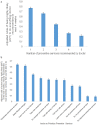Assessing Patient Interest in Individualized Preventive Care Recommendations
- PMID: 31192307
- PMCID: PMC6540511
- DOI: 10.1177/2381468319850803
Assessing Patient Interest in Individualized Preventive Care Recommendations
Abstract
Background. Few Americans obtain all 41 guideline-recommended preventive services for nonpregnant adults. We assessed patient interest in prioritizing their preventive care needs. Methods. We conducted a mixed-methods study, with 4 focus groups (N = 28) at a single institution and a nationwide survey (N = 2,103). Participants were middle-aged and older adults with preventive care needs. We obtained reactions to written materials describing the magnitude of benefit from major preventive services, including both absolute and relative benefits. Recommendations were individualized for patient risk factors ("individualized preventive care recommendations"). Focus groups assessed patient interest, how patients would want to discuss individualized recommendations with their providers, and potential for individualized recommendations to influence patient decision making. Survey content was based on focus groups and analyzed with logistic regression. Results. Patients expressed strong interest in individualized recommendations. Among survey respondents, an adjusted 88.2% (95% confidence interval [CI] = 86.7% to 89.7%) found individualized recommendations very easy to understand, 77.2% (95% CI = 75.3% to 79.1%) considered them very useful, and 64.9% (95% CI = 62.8% to 67.0%) highly trustworthy (each ≥6/7 on Likert scale). Three quarters of participants wanted to receive their own individualized recommendations in upcoming primary care visits (adjusted proportion = 77.5%, 95% CI = 75.6% to 79.4%). Both focus group and survey participants supported shared decision making and reported that individualized recommendations would improve motivation to obtain preventive care. Half of survey respondents reported that they would be much more likely to visit their doctor if they knew individualized recommendations would be discussed, compared with 4.2% who would not be more likely to visit their doctor. Survey respondents already prioritized preventive services, stating they were most likely to choose quick/easy preventive services and least likely to choose expensive preventive services (adjusted proportions, 63.8% and 8.5%, respectively). Results were consistent in sensitivity analyses. Conclusions. Individualized preventive care recommendations are likely to be well received in primary care and might motivate patients to improve adherence to evidence-based care.
Keywords: Decision Making; Preventive Health Services; Preventive Medicine; Shared.
Conflict of interest statement
The author(s) declared no potential conflicts of interest with respect to the research, authorship, and/or publication of this article. This study was approved by the Institutional Review Board of Cleveland Clinic.
Figures



Similar articles
-
Effect of Individualized Preventive Care Recommendations vs Usual Care on Patient Interest and Use of Recommendations: A Pilot Randomized Clinical Trial.JAMA Netw Open. 2021 Nov 1;4(11):e2131455. doi: 10.1001/jamanetworkopen.2021.31455. JAMA Netw Open. 2021. PMID: 34726747 Free PMC article. Clinical Trial.
-
Adolescents' preventive care experiences before entry into the State Children's Health Insurance Program (SCHIP).Pediatrics. 2003 Dec;112(6 Pt 2):e533. Pediatrics. 2003. PMID: 14654675
-
Mammography decision making: Trends and predictors of provider communication in the Health Information National Trends Survey, 2011 to 2014.Cancer. 2017 Feb 1;123(3):401-409. doi: 10.1002/cncr.30378. Epub 2016 Oct 11. Cancer. 2017. PMID: 27727457 Free PMC article.
-
How to develop cost-conscious guidelines.Health Technol Assess. 2001;5(16):1-69. doi: 10.3310/hta5160. Health Technol Assess. 2001. PMID: 11427188 Review.
-
Canadian Contraception Consensus (Part 1 of 4).J Obstet Gynaecol Can. 2015 Oct;37(10):936-42. doi: 10.1016/s1701-2163(16)30033-0. J Obstet Gynaecol Can. 2015. PMID: 26606712 English, French.
Cited by
-
Personalized Disease Prevention (PDP): study protocol for a cluster-randomized clinical trial.Trials. 2022 Oct 22;23(1):892. doi: 10.1186/s13063-022-06750-7. Trials. 2022. PMID: 36273151 Free PMC article.
-
Effect of Individualized Preventive Care Recommendations vs Usual Care on Patient Interest and Use of Recommendations: A Pilot Randomized Clinical Trial.JAMA Netw Open. 2021 Nov 1;4(11):e2131455. doi: 10.1001/jamanetworkopen.2021.31455. JAMA Netw Open. 2021. PMID: 34726747 Free PMC article. Clinical Trial.
-
Stakeholders' perceptions and experiences of factors influencing the commissioning, delivery, and uptake of general health checks: a qualitative evidence synthesis.Cochrane Database Syst Rev. 2025 Mar 20;3(3):CD014796. doi: 10.1002/14651858.CD014796.pub2. Cochrane Database Syst Rev. 2025. PMID: 40110911
References
-
- US Preventive Services Task Force. USPSTF A and B recommendations [cited July 10, 2018]. Available from: http://www.uspreventiveservicestaskforce.org/Page/Name/uspstf-a-and-b-re...
-
- Borsky A, Zhan C, Miller T, Ngo-Metzger Q, Bierman AS, Meyers D. Few Americans receive all high-priority, appropriate clinical preventive services. Health Aff (Millwood). 2018;37(6):925–8. - PubMed
-
- Stacey D, Légaré F, Lewis KB. Patient decision aids to engage adults in treatment or screening decisions. JAMA. 2017;318(7):657–8. - PubMed
Grants and funding
LinkOut - more resources
Full Text Sources
Medical

